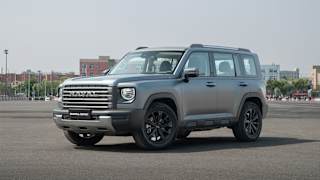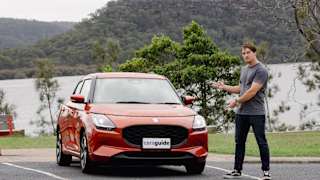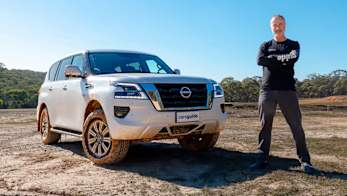Tim Robson road tests and reviews the 2017 Mitsubishi ASX LS 2WD petrol with specs, fuel consumption and verdict.
Mitsubishi is in a bit of a strange place now, as it gets used to life under its new masters at Nissan Renault – and, being by far the smaller of the three companies, many of its future plans are now under a financial spotlight, as the its new owners look to see if it can save money by sharing platforms and drivetrains across all its brands.
MORE: Read the full Mitsubishi ASX 2017 review
As a result, cars that have already had a long shelf life – like the Lancer - are being asked to soldier on for a couple more years, often in the face of already sliding sales.
The small ASX SUV is one of the brighter spots in Mitsubishi Australia’s sales playbook, and it’s the only car to keep the dominant Mazda CX-3 honest in the sales charts.
The company gave the ASX – which launched in 2011 - a very light tickle-up for 2017, but is it enough to keep it in the hunt in a very tough category?
Does it represent good value for the price? What features does it come with?
The front-wheel drive (FWD) petrol powered LS is the cheapest way to get into the ASX, and pricing starts from $25,000 plus on-roads in manual form. It costs $27,000 with a continuously variable transmission (CVT).
Its reasonably basic spec list includes climate control air conditioning, reversing camera with sensors, keyless entry, a 6.1-inch multimedia screen with Bluetooth (no Apple CarPlay or Android Auto, though it claims to have ‘iPod control’), manual seats with cloth trim and a leather-wrapped steering wheel.
Its biggest party trick is that it’s distinctly larger than others in the category.
It comes standard on 18-inch alloy rims, while halogen headlights and foglights feature on the revised front end – but almost inexplicably, Mitsubishi has deleted the LED daytime running lamps of the previous model.
Is there anything interesting about its design?
The ASX was one of the earliest small to mid-sized SUVs on the market, and while its basic shape was contemporary and interesting when it launched, subsequent updates and facelifts haven't really done it any favours.
It now has an overly styled front thanks mainly to the corporate insistence on the brand’s so-called 'Dynamic Shield' grille and front bar, which doesn't really blend with a rear which has not been updated at all since its launch.
It's essentially inoffensive, but it’s not a patch on more modern designs like the Mazda CX-3 and Toyota RAV4. Still, the fact it isn’t all square edges and squinty LED headlights is a plus for many.
Inside, it’s a somber story. There are literally square metres of hard, cheap, featureless plastic throughout the cabin, no digital speedo, no electronic handbrake and a relatively featureless dash and centre console.
The colour palette includes solid white, 'Starlight Silver', 'Cool Silver', red, 'Lightning Blue', 'Titanium Grey' and black.
How practical is the space inside?
In a sense, the ASX is a very practical car in that it has very little in the way of distractions to take the focus off the task of simply driving from A to B.
Its biggest party trick is that it’s distinctly larger than others in the category, like the CX-3 and the Honda HR-V; its 393 litres of boot space, for example, is around 130 litres larger than the CX-3’s offering. The rear extends to 1193 litres with the seats down.
Storage in the front is adequate, with a mobile phone holder hidden under the dash. There are three cupholders in the front, small bottle holders in each of the four doors, and two cupholders in the centre of the rear seats.
There are no power points in the rear of the vehicle, though there are two 12 volt points and a single USB for front seat passengers, along with a deep, hard plastic-lined centre bin. Air conditioning and heating is ducted to the rear via vents in the floor.
In a bonus for the ASX, the dimensions of the rear seat are big enough for three teenage children, and there is adequate headroom to taller passengers. Two ISOFIX seat mounts are included.
The driver's seat is just okay, though the short squab digs into the driver's thighs on longer trips.
One annoyance; when the rear seats are folded down, the seat belts remain in place, which takes away some of the luggage space.
The small 6.1-inch colour touch screen-based multimedia system does have digital radio, which is nice, but the Bluetooth system would not connect to any Apple or Android product during our test period, no matter what we did.
What are the key stats for the engine and transmission?
A 2.0-litre four-cylinder naturally aspirated petrol engine that makes 110kW/197Nm is matched with an older generation continuously variable transmission (CVT) driving the front wheels in the ASX LS… and it’s not a match made even within sight of a street sign indicating where heaven might be.
The gearbox and engine combination, unfortunately, is truly uninspiring, and it’s an issue that shows up the ASX’s age more than any other part of the car.
It doesn’t deliver meaningful pace from low in the rev range, the motor sounds and feels cringeworthy with any revs on board, and the flaring of the engine as the CVT winds up is almost unbearable. It’s unpleasant around town, and it’s noisy on the freeway; not an ideal combination.
How much fuel does it consume?
Mitsubishi rates the ASX LS at 7.4L/100km on the combined fuel economy cycle, while we recorded 9.3L/100km after 330km via the dash.
Its 60-litre tank needs only 91 RON fuel, and the car has a theoretical range of 810km.
What's it like to drive?
Oh dear. There’s a point where cheap and cheerful becomes a lot less cheery, and the ASX LS crosses that line.
The car’s steering has a very strange, friction-heavy feel just off centre, which is disconcerting, and almost impossible to get used to or manage. The throttle’s response underfoot is glacial and noisy, and its ride is unsettled and uncomfortable, particularly in terms of body roll.
There was a continual and very irritating creak coming from what seems to be the entire dashboard area on our tester, and other issues – a fault that led to an inability to connect the Bluetooth, for one, as well as air con that just barely coped with a 40-degree C day – all served to irritate and spoil the experience.
On the positive side, the cabin can cope with five people aboard in relative comfort, which is unusual for a small SUV. Head and knee room were good for rear seat riders even up to 180cm.
The ground clearance of the front-wheel drive (FWD) LS is actually slightly higher than that of the AWD ASX at 205mm (versus 180mm), thanks to the lack of AWD gear hanging under the car.
It can tow 1300kg of braked trailer, which covers light vans and camper trailers, as well as smaller boats.
What safety equipment is fitted? What safety rating?
The age of the ASX essentially doesn’t allow it to adopt any modern electronic safety aids like AEB or radar cruise control. It does have emergency brake assist, however, along with seven airbags.
It’s rated at a maximum five from five stars on the ANCAP safety rating scale.
What does it cost to own? What warranty is offered?
Mitsubishi offers a five-year, unlimited kilometre warranty, four years of free roadside assistance and a three-year capped price servicing program for the ASX.
Due every 15,000km or 12 months, each service cost is $230. The servicing arrangement will expire if the car travels more than 52,500km within the three year period, though.
The ASX enjoys a reputation for being a low-maintenance, worry-free car, with little history of recalls or problems to report.
Mitsubishi ASX 2017: LS (2WD)
| Engine Type | Inline 4, 2.0L |
|---|---|
| Fuel Type | Unleaded Petrol |
| Fuel Efficiency | 7.6L/100km (combined) |
| Seating | 5 |
| Price From | $13,750 - $18,040 |
| Safety Rating |
|
Verdict
Looking at the entry level ASX, its size-to-dollar ratio is better than that of both of its key rivals, the CX-3 and the HR-V. However, in isolation, there are much better ways to spend the better part of $27,000.
The car is safe, roomy and reasonably comfortable, but it was built down to a price even when it was new in 2010, and the automotive world has moved on in light years since then. Even its more expensive diesel sibling is a significantly nicer car to live with.
Pricing Guides







.jpg)
.jpg)
.jpg)
.jpg)
.jpg)
.jpg)
.jpg)
.jpg)
.jpg)
.jpg)
.jpg)
.jpg)
.jpg)
.jpg)
.jpg)
.jpg)



.jpg)








.png)








.jpg)
.jpg)
.jpg)
.jpg)
.jpg)
.jpg)
